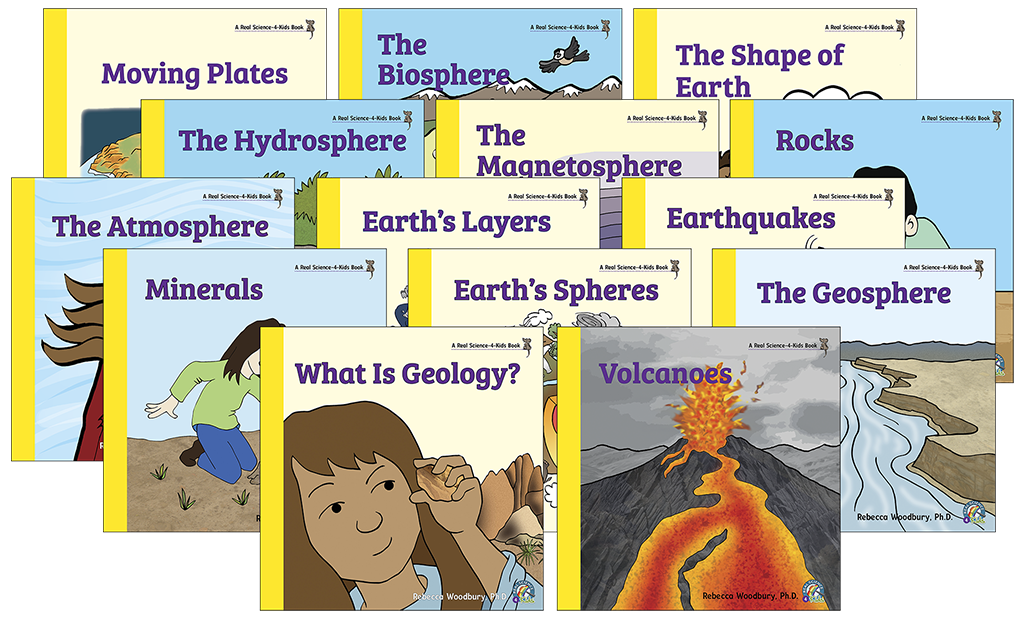Geology Reader Bundle includes fourteen (14) Books.
In Geology, young readers are introduced to basic information about how Geologists study Earth to find out how rocks are formed, how mountains are created and what is under the ocean. Changes to Earth can take long periods of time or can occur quickly. By studying Earth we can learn how to take care of it.
In Earthquakes, young readers learn the earth’s crust and upper mantle are broken up into huge pieces called plates that are carried along by moving magma in the lower mantle. The sudden release of 2 plates that are stuck at their edges causes an earthquake and seismic waves.
In Earth's Layers, young readers learn Earth is a terrestrial planet thought to be made of 3 layers: crust, mantle, core. Scientists can’t see the interior of Earth, but studying earthquakes and volcanoes indicates what it may be like. The characteristics of each layer are described.
In Earth Spheres, young readers learn the earth is sphere-shaped and surrounded by different layers: the geosphere, hydrosphere, biosphere, atmosphere, and magnetosphere. The spheres work together and separately to support life on Earth. Studying them helps us understand how Earth works.
In Minerals, young readers are introduced to basic information how Minerals form from molten magma. When magma cools slowly, molecules can line up in an orderly way to make minerals. Minerals can form crystals, with each mineral having crystals of a specific shape. They can be different colors depending on the atoms included. Atoms and molecules are defined.
In Moving Plates, young readers learn Earth is made up of different layers. The solid crust and upper mantle are broken up into huge plates that are carried along by the movement of magma in the lower mantle. Plate movements cause earthquakes, volcanoes, and mountain formation.
In Rocks, young readers discover rocks form when magma (molten material) inside Earth cools. The three main types of rock are igneous, sedimentary, and metamorphic. Each type of rock is defined. Geologists study the features of rocks and do tests to classify them.
In The Atmosphere, young readers learn the earth’s atmosphere contains the air we breathe and is made up of different gas molecules. Lungs have special cells to take the oxygen out of the air so the body can use it to make energy. All weather occurs in the atmosphere.
In The Biosphere, young readers learn the biosphere is made up of all the living things on Earth and the land, water, and air where living things exist. Each type of plant and animal lives in a place that provides what it needs to grow and survive. Environment and habitat are defined.
In The Geosphere, young readers learn the geosphere is made up of layers: crust, mantle, and core. Volcanoes, earthquakes, erosion, glaciers, and animals make big and small changes to the geosphere. Energy resources come from the geosphere. Rock layers and fossils tell Earth’s history.
In The Hydrosphere, young readers learn the hydrosphere is made up of all the water on Earth. Water exists in three forms—liquid, solid, and water vapor. Water moves around Earth in the water cycle. Water is necessary for life on Earth, and it is important to keep water clean.
In The Magnetosphere, young readers learn earth has a magnetic field that begins in the core, surrounds Earth, and extends out into space. The magnetosphere protects Earth from getting too much energy from the Sun and is formed by light energy from the Sun hitting Earth’s magnetic field.
In The Shape of Earth, young readers are prompted to think about the shape of Earth. They learn why Earth seems flat when it is actually ball-shaped.
In Volcanoes, young readers learn the squeezing of rocks and minerals deep in the Earth causes them to get so hot that they melt to form magma. When magma pushes through a weak spot in Earth’s solid crust, a volcano occurs. Magma that comes to Earth’s surface is called lava.
top of page
Everything you could possibly need!
$280.00 Regular Price
$238.00Sale Price
Only 2 left in stock
Best sellers
bottom of page












